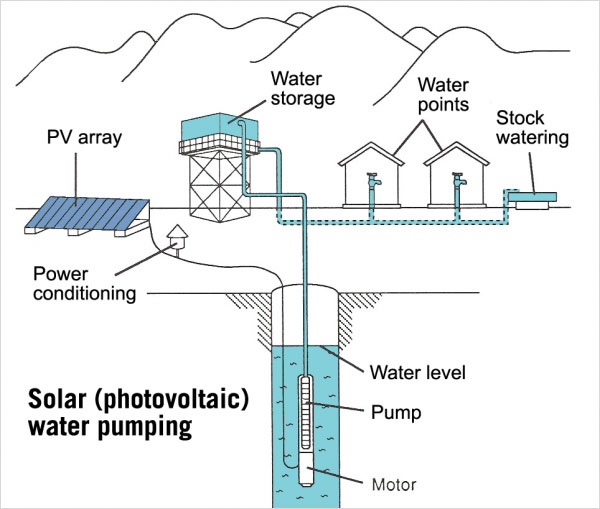
INTRODUCTION TO SOLAR WATER PUMPING SOLUTIONS
A solar-powered pump is a pump running on electricity generated by solar photovoltaic panels available from collected sunlight as opposed to grid electricity or diesel run water pumps. The operation of solar powered pumps is more economical mainly due to the lower operation and maintenance costs and has less environmental impact than pumps powered by an internal combustion engine (ICE). Solar pumps are useful where grid electricity is unavailable and alternative sources (in particular wind) do not provide sufficient energy.
Components
A photovoltaic solar powered pump system has three parts:
- The pump & motor
- The controller
- Solar panels
The solar panels make up most (up to 80%) of the systems cost. The size of the PV-system is directly dependent on the size of the pump, the amount of water that is required (m?/d) and the solar irradiance available.
The purpose of the controller is twofold. Firstly, it matches the output power that the pump receives with the input power available from the solar panels. Secondly, a controller usually provides a low voltage protection, whereby the system is switched off, if the voltage is too low or too high for the operating voltage range of the pump. This increases the lifetime of the pump thus reducing the need for maintenance.

Voltage of the solar pump motors can be AC (alternating current) or DC (direct current). Direct current motors are used for small to medium applications up to about 3 kW rating, and are suitable for applications such as garden fountains, landscaping, drinking water for livestock, or small irrigation projects. Since DC systems tend to have overall higher efficiency levels than AC pumps of a similar size, the costs are reduced as smaller solar panels can be used.
Finally, if an alternating current solar pump is used, an inverter is necessary that changes the direct current from the solar panels into alternating current for the pump. The supported power range of inverters extends from 0.15 to 55 kW and can be used for larger irrigation systems. However, the panel and inverters must be sized accordingly to accommodate the inrush characteristic of an AC motor.
Water pumping
Solar powered water pumps can deliver drinking water as well as water for livestock or irrigation purposes. Solar water pumps may be especially useful in small scale or community based irrigation, as large scale irrigation requires large volumes of water that in turn require a large solar PV array.
Solar PV water pumping systems are used for irrigation and drinking water across the globe. The majority of the pumps are fitted with a 200 watt – 3,000 watt motor that receives energy from a 1,800 Wp PV array. The larger systems can deliver about 140,000 liters of water/day from a total head of 10 meters.
Benefits Of Solar Water Pumps
- Solar water pumps are used for irrigation of crops, water livestock and provide portable drinking water.
- Solar water pump uses peak solar array output which frequently coincides with high water demand during long, dry summer days.
- In the event of cloudy weather solar water pump systems often use storage tanks to store excess water.
- Solar water pumps do not require fuel or constant maintenance.
- Solar water pumps can also be designed for portability to be moved based on water demand or change of season requires.
- Their operating cost is less compared to diesel pumps.
- Recent fuel price increases and generally intensive maintenance schedules however can make diesel pumps expensive.
How Solar Pumps score over conventional pumps
- Solar pumps are good for bore holes as they pump over the whole day
- Weak boreholes can be used effectively with a low volume pump due to pumping 8 to10 hours a day
- Require minimal attention since they are self-starting
- To increase daily water pumping rates, tracking arrays can be used
- Environment friendly
- Solar pumps offer clean solutions with no danger of borehole contamination
Features
- MPPT – Max Power Point Tracking for maximising efficiency of input power
- No Surge Load which means no chance of breakdown due to voltage fluctuations or overdrawing
- Complete Stainless Steel System – AISI 304 standard
- AC-DC Functionality.
- Customised to every clients dynamic requirement
- Standard option from 0.5HP to 40HP
Package Includes
- Submersible or Monoblock Pump and Motor
- Solar PV Array as per IEC & IS Standards
- Solar Driver/Controller based on MPPT technology
- Three core wiring
- Panel mounting structure with seasonal (manual or automatic) tilt for greater efficiencies.
- Standard option from 0.5HP to 40HP

